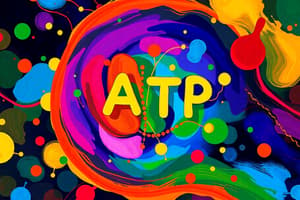Podcast
Questions and Answers
What is the primary function of the small intestine in the digestive process?
What is the primary function of the small intestine in the digestive process?
- To mechanically digest food
- To absorb most nutrients and water (correct)
- To store bile
- To secrete hormones
Which of the following enzymes is responsible for the digestion of starch?
Which of the following enzymes is responsible for the digestion of starch?
- Lactase
- Lipase
- Pepsin
- Amylase (correct)
What prevents the backflow of stomach contents into the esophagus?
What prevents the backflow of stomach contents into the esophagus?
- Upper esophageal sphincter
- Pyloric sphincter
- Epiglottis
- Lower esophageal sphincter (correct)
During which phase of digestion does peristalsis occur?
During which phase of digestion does peristalsis occur?
Which structure assists in producing bile that helps in the chemical breakdown of fats?
Which structure assists in producing bile that helps in the chemical breakdown of fats?
Which of the following does NOT occur in the stomach during digestion?
Which of the following does NOT occur in the stomach during digestion?
What term describes the mass of food mixed with saliva that moves from the mouth through the esophagus?
What term describes the mass of food mixed with saliva that moves from the mouth through the esophagus?
What is the main role of the pancreas in digestion?
What is the main role of the pancreas in digestion?
What is the composition of feces as it is formed in the large intestine?
What is the composition of feces as it is formed in the large intestine?
Which hormone stimulates the secretion of gastric acid in the stomach?
Which hormone stimulates the secretion of gastric acid in the stomach?
What symptom is commonly associated with peptic ulcers?
What symptom is commonly associated with peptic ulcers?
Which of the following is a common cause of diarrhea?
Which of the following is a common cause of diarrhea?
What is the primary treatment focus in case of diarrhea?
What is the primary treatment focus in case of diarrhea?
What condition occurs when diverticuli become inflamed?
What condition occurs when diverticuli become inflamed?
What dietary substance triggers an immune response in celiac disease?
What dietary substance triggers an immune response in celiac disease?
Which symptom is associated with constipation?
Which symptom is associated with constipation?
What is typically a long-term solution to manage peptic ulcers?
What is typically a long-term solution to manage peptic ulcers?
What lifestyle change can help alleviate symptoms of constipation?
What lifestyle change can help alleviate symptoms of constipation?
What is the primary function of ATP in cells?
What is the primary function of ATP in cells?
Which of the following best describes catabolic reactions?
Which of the following best describes catabolic reactions?
How does basal metabolic rate (BMR) differ from resting metabolic rate (RMR)?
How does basal metabolic rate (BMR) differ from resting metabolic rate (RMR)?
What factors can influence an individual's basal metabolic rate (BMR)?
What factors can influence an individual's basal metabolic rate (BMR)?
What role does digestion play in relation to the cells?
What role does digestion play in relation to the cells?
What is the relationship between catabolic and anabolic reactions?
What is the relationship between catabolic and anabolic reactions?
Which aspect of metabolism involves building larger molecules from smaller subunits?
Which aspect of metabolism involves building larger molecules from smaller subunits?
What is the digestive system primarily responsible for?
What is the digestive system primarily responsible for?
Flashcards are hidden until you start studying
Study Notes
Energy for Cells
- All cells require energy for growth, repair, and movement.
- Energy is released by breaking down food molecules.
- This energy is used to produce ATP.
- ATP acts as a "charged battery" for cells, providing energy where needed.
- The "drained battery" form of ATP, ADP, can be recharged using energy from food.
Metabolism
- Metabolism refers to the biochemical reactions that occur within living organisms for maintaining life.
- Catabolic reactions break down larger molecules into smaller subunits, releasing energy.
- Anabolic reactions build larger molecules from smaller ones, requiring energy.
- Both types of reactions are coupled within metabolic processes.
Metabolic Rates
- Metabolic rate measures the amount of energy (calories) used over a specific time.
- Individual metabolic rates vary greatly.
- Basal Metabolic Rate (BMR): Calories burned during basic life-sustaining functions.
- Resting Metabolic Rate (RMR): Calories burned while resting all day.
- Weight, height, age, and sex factor into BMR calculations.
- Genetics and hormones also influence metabolic rates.
Functions of the Digestive System
- Digestion: Break down large food molecules into smaller subunits.
- Absorption: Transporting these subunits into the bloodstream or lymph.
- Excretion: Eliminating undigested waste.
- Microbial elimination: Removal of microbes that enter with food (assisted by the immune system).
Mechanical Digestion
- Involves physical breakdown of food.
- Includes chewing in the mouth and contractions within the stomach.
- Peristalsis: Muscular contractions that propel food through the gastrointestinal tract.
Chemical Digestion
- Enzymes: Proteins that speed up chemical reactions.
- Major digestive enzymes:
- Amylase: Breaks down starch (carbohydrate).
- Lipase: Breaks down lipids (fats).
- Peptidase, Protease, Pepsin: Break down peptides (proteins).
- Lactase: Breaks down lactose (milk sugar).
- Sucrase: Breaks down sucrose (table sugar).
Gastrointestinal Tract
- Major parts:
- Mouth
- Esophagus
- Stomach
- Small intestine
- Large intestine
- Rectum
- Anus
- Different parts of the digestive system break down and absorb molecules.
- For example, fats are broken down into components in the small intestine.
Accessory Organs of the GI Tract
- Contribute to chemical food breakdown by producing acids and enzymes.
- Includes:
- Salivary glands: Secrete saliva for lubrication, and contain amylase and lipase.
- Liver: Secretes bile and purifies blood from the small intestine.
- Gallbladder: Stores bile.
- Pancreas: Produces digestive enzymes, including peptidase.
Movement of Food Through the GI Tract
- Peristalsis: Waves of contractions that push food through the GI tract.
- Sphincters: Muscular rings that prevent backflow or early release of food.
- Stages of Food Breakdown:
- Bolus: Food and saliva mixture traveling from mouth to stomach.
- Chyme: Partially digested food and secretions (from the liver and pancreas) moving through the intestines.
- Feces: Undigested fiber, connective tissue, bacteria, and intestinal cells excreted through the large intestine.
Functions of the Mouth
- Taste analysis occurs.
- Mechanical digestion:
- Chewing breaks down food.
- Swallowing moves food into the esophagus.
- Saliva lubricates food.
- Limited chemical digestion:
- Salivary amylase breaks down starch.
- Salivary lipase breaks down fat.
- Absorption does not occur yet.
Esophagus
- Connects the pharynx (back of the mouth) to the stomach.
- Epiglottis: Prevents food from entering the trachea (windpipe).
- Lower esophageal sphincter: Prevents stomach contents from flowing back into the esophagus.
Stomach
- Performs both mechanical and chemical digestion.
- Mucus: Protects the stomach lining from acid.
- Hydrochloric acid (HCl): Breaks down proteins and activates digestive enzymes.
- Enzymes:
- Pepsin: Digests proteins.
- Intrinsic factor: Essential for vitamin B-12 absorption.
- Gastrin: Stimulates mucus and HCl production.
Small Intestine
- Site of most chemical digestion and nutrient absorption.
- Increased surface area due to folded villi.
- Three segments:
- Duodenum: Food mixes with pancreatic juices and bile.
- Jejunum: Absorbs nutrients and water.
- Ileum: Absorbs remaining nutrients and water.
Molecules Absorbed in the Small Intestine
- Glucose
- Amino acids
- Fats
- Vitamins
- Most minerals (e.g., calcium, magnesium, iron)
- Water
- Alcohol
Pancreas
- Large gland associated with the digestive system.
- Produces hormones and enzymes.
- Proteases: Break down proteins.
- Trypsin: Most important protease from the pancreas.
- Pancreatic amylase: Breaks down starches.
- Pancreatic lipase: Breaks down fats.
- Nucleases: Break down nucleic acids.
Large Intestine, Rectum, Anus
- Absorbs water, minerals, and vitamins.
- Compacts feces (undigested material, fiber, bacteria, and dead cells).
- Rectum: Collects and stores feces, absorbs water and electrolytes.
- Anus: The exit point for waste.
Common Diseases of the GI Tract: GERD
- Gastroesophageal Reflux Disease
- Stomach acid or bile flows back into the esophagus.
- Symptoms: Burning chest pain that worsens after eating or lying down.
- Often managed with lifestyle changes and over-the-counter medications.
Common Diseases of the GI Tract: Peptic Ulcers
- Stomach acid erodes the lining of the stomach, esophagus, or duodenum.
- Causes:
- Helicobacter pylori infection.
- Nonsteroidal anti-inflammatory drugs (NSAIDs).
- Symptoms: Stomach pain, weight loss, lack of appetite, nausea.
Common Diseases of the GI Tract: Diarrhea
- Frequent, watery bowel movements.
- Causes:
- Infections (microorganisms)
- Malabsorption (e.g., lactose intolerance).
- Excessive fiber.
- Treatment: Preventing dehydration, fluid and electrolyte replacement, dietary changes.
- Seek Medical Attention: Prolonged diarrhea, dehydration, blood in stool.
Common Diseases of the GI Tract: Constipation
- Difficulty or infrequent bowel movements.
- Causes:
- Ignoring the urge to defecate.
- Low-fiber diet.
- Muscle or nerve problems.
- Supplements (e.g., calcium, iron).
- Management: Dietary changes, increased fluid intake, physical activity.
Common Diseases of the GI Tract: Diverticulosis and Diverticulitis
- Diverticular disease: Formation of balloon-like structures in the intestinal wall (diverticuli).
- Diverticulitis: Inflammation or rupture of diverticuli, often caused by food getting trapped.
- Foods to avoid: Corn and other small, not-easily-digestible foods.
- High-fiber diets: Help prevent food from getting trapped.
Common Diseases of the GI Tract: Celiac Disease
- Chronic immune response to dietary gluten.
- Flattens the villi of the small intestine, causing nutrient malabsorption.
- Sources of Gluten: Wheat, barley, rye.
- Symptoms: Diarrhea, cramps, bloating, flatulence, fatigue, weight loss, anemia.
Studying That Suits You
Use AI to generate personalized quizzes and flashcards to suit your learning preferences.



